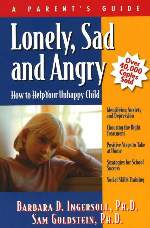Lonely, Sad and Angry: How to Help Your Unhappy Child by Barbara D. Ingersoll, Ph.D. and Sam Goldstein, Ph.D.

Review by Kathy Kuhl
Lonely, Sad, and Angry: Help for Your Unhappy Child. 2001. ISBN 978-1886941458

Does anger, loneliness, or sadness dominate the life of a child you know—not just for a few bad days, and maybe not every hour—nearly every day? It could be depression. How do you know?
Psychologists Barbara Ingersoll and Sam Goldstein’s book, Lonely, Sad, and Angry: How to Help Your Unhappy Child, gives parents the information and guidance we need when a child’s emotional condition concerns us. As in their other books, they combine expert knowledge with a clear style, an obvious concern for children, teen, and parents, and years of experience helping families.
In the first chapter, “What is Childhood Depression,” Ingersoll and Goldstein explain how depression looks different in children than in adults, the varieties of depression, and how they can look in infancy, childhood, and adolescence.
To be diagnosed with depression, a person must have at least five of the following symptoms (including at least one of the first two) for at least part of most days for at least two weeks. The individual symptoms aren’t unusual—it’s the combination of symptoms, over a period of weeks,“that cause significant distress” or impair functions (p. 5) that alert us to a possible problem.
- Depressed or an irritable mood
- Diminished interest and pleasure in activities. (Everything is ‘boring’ or ‘dumb.’)
- Significant change in appetite or weight
- Sleep problems
- Physical slowness or restlessness
- Fatigue, loss of energy
- Feeling worthless or excessively or inappropriately guilty
- Increased trouble thinking, concentrating or deciding
- “Recurrent thoughts of suicide or death, or a suicide plan or attempt.”
[Some of these surprised me. I never thought of irritability as a sign of depression, for instance. This list is from the American Psychiatric Associations Diagnostic and Statistical Manual, 4th ed., but Ingersoll and Goldstein provide more than a list. They explain each symptom as it appears in children and teens.]
The next chapters cover other conditions that can accompany depression and how to go about getting a diagnosis. Since many of us are reluctant to seek help from mental health professionals, this chapter is particularly helpful. In a sympathetic, clear way, it describes what to expect.
Causes of depression, methods of psychological treatments (including various types of psychotherapy, choosing a therapist, and the costs), and medications and alternative treatments are the topics of the next chapters. The chapter on medications includes an intelligent discussion of pros and cons. The authors are not overeager to medicate. (It is worth noting this book is ten years old. Nevertheless, it is a good survey of the basics: how different kinds of medications work, benefits, risks, and missteps to avoid as you educate yourself—for example, common mistakes made reading the Physicians Desk Reference.
The last chapters address what do in a crisis (suicidal behavior and psychiatric hospitalization), how family can help in daily life, the depressed child in school, and finally, the rise of childhood depression, the reasons behind it, and how to combat it.
Barbara Ingersoll and Sam Goldstein have written a clear, short, useful guide to difficult problems. I recommend it. It’s out of print, but still available.

